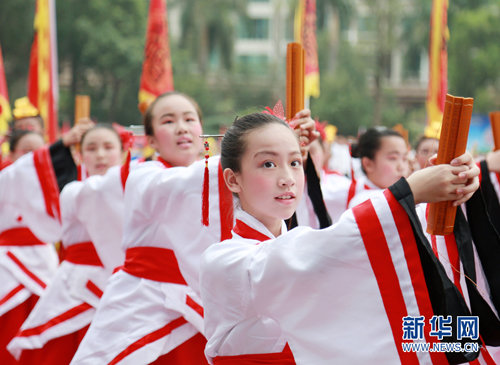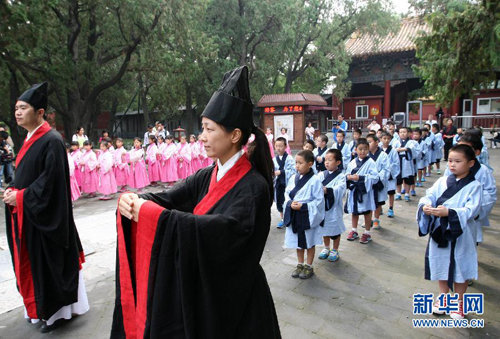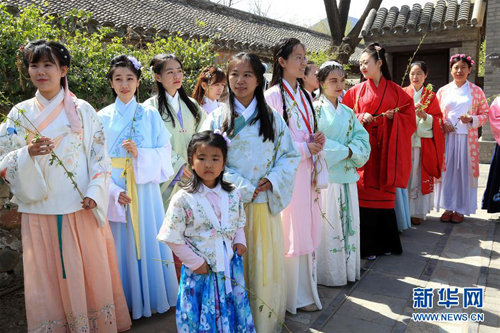
Girls wear Hanfu to worship the Yellow Emperor. [Xinhua]
Shangsi Festival, or Double Third Festival, is an ancient Chinese festival celebrated on the third day of the third lunar month, to remember the birthday of Huangdi, also known as the legendary Yellow Emperor.
A special part of Shangsi Festival is the Hanfu Show in Xi'an. Hanfu clothing appeared in China over 3,000 years ago and was said to be worn by the Yellow Emperor, who was a great sage king of ancient times.
The basic style of Hanfu was developed in the time of the Shang Dynasty (1600 B.C.-1046 B.C.), and has since left a deep influence on Chinese culture.
Hanfu's Features
Hanfu is characterized by crossed collars, tied to the right, and long skirts or trousers in varying lengths. The look also consists of a yi, a narrow-cuffed, knee-length tunic tied with a sash, and a narrow, ankle-length skirt, called a chang, worn with a bixi, a length of fabric that reaches the knees.
Shenyi
The shenyi, literally deep robe, was invented in the Eastern Zhou Dynasty (770 B.C.-256 B.C.). A combination of a tunic and a skirt, it was cut separately but sewn together as a piece of clothing with the left side of the costume shaped into a corner, which was used for closing the shenyi by fastening it on the chest. The shenyi could be worn by anybody regardless of gender, profession or social class.
Ruqun
A ruqun is an item of traditional Hanfu costume primarily worn by ancient Chinese people. It consists of a short blouse and a wrap-around skirt, no longer than the knees. It is said to be the basic clothing for women. From the Warring States period (453 B.C.-221 B.C.) to the Ming Dynasty (1368-1644), although the length and breadth of the ruqun varied, the basic form still maintained its original design.
Banbi
Banbi, also known as Banxiu, was a popular item for women worn in pre-Tang Dynasty (618-907) time. It is a form of waistcoat or outerwear worn over a ruqun, with half-length sleeves. The coat is only tied with the strap in front of the chest. The sleeve covers the shoulder area and there is no opening in the front or back. In order to wear it, one would have to tuck their head out from the neck of the clothing, like a short windbreaker of today.
Quju
The Quju is actually a kind of deep robe. It is a diagonal body wrapping, with curved lapels. The garment forms a triangle, which is then circumvented to the front and restrained at the waist with a large band to cover the ends. It may be referred to in ancient books as "continued gusset and crocheting". "Crocheting" probably describes the style of winding gussets.
Tanling
Tanling, or flat collar shirt, is a large, half-sleeved shirt made of leno and worn by women in the Tang Dynasty (618-906). The lower body is equipped with a long skirt that fully reflects the graceful posture and natural beauty of women. The clothes of Tang women basically included a shirt or jacket for the upper body and lower outer garment tunic, with the silk shawl on the shoulder, so as to follow the format of a flat collar.
Beizi
Beizi is a traditional Chinese attire common to both men and women. It is a large, loose coat. It was popular during the Sui and Tang dynasties (581-907). Beizi is a mixture of Hanfu and northern China's ethnic costume. It has no sleeves, similar to today's vest. It can keep in heat without the need for increasing the thickness of sleeves, facilitating better movement. It enjoyed much popularity in the Song, Yuan and Ming dynasties.
Hanfu is Han ethnic people's clothing, rather than people of the Han Dynasty (202 B.C.-220 A.D.). Modern clothes can also be classified into the Hanfu category if they absorb its clothing elements.

People wear Hanfu. [Xinhua]

Women wear Hanfu. [Xinhua]

